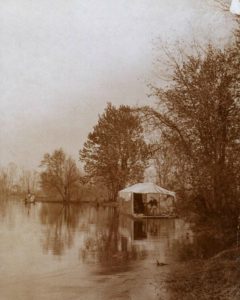The conservation movement was in its infancy when Lew Wallace was alive. An avid sportsman, including hunting and fishing, Lew loved the outdoors.
The Grand Kankakee Marsh
One of Lew Wallace’s favorite places on earth was the Grand Kankakee Marsh that spread across Northwestern Indiana into Illinois. Over the course of his life, he often traveled to the marsh to fish and hunt. He owned a houseboat, descriptively called The Thing, which served as his home base while on the marsh.

The U.S. Fish & Wildlife Service website says the Grand Kankakee Marsh covered up to 500,000 acres of land. (Other sources claim up to 1 million acres.) The first European explorer to visit the marsh was La Salle in 1679, but the Native Americans had already been living there for generations. Throughout the 1860s and 1870s numerous attempts were made to drain the marsh, but by the 1880s it had become a hunter’s paradise.
“Never, in all my world travels, have I found a more perfect spot, not a more tantalizing river.”
Bass Lake
According to the Starke County Historical Society, Lew spent a great deal of time at Bass Lake. Locals named a tree the Ben Hur Oak (much like our Ben-Hur Beech!) because he sat under the tree and wrote. Sportsmen’s clubs were common along the Kankakee, including the Ben Hur Club, run by a Civil War veteran and acquaintance of Lew’s. Prominent figures such as the Studebaker family, President Teddy Roosevelt, and others came to the marsh to relax.
The glory days of the Grand Kankakee Marsh were not to last, unfortunately. Counterfeiters and other criminals on Bogus Island (located in what was the largest freshwater lake in Indiana), along with increased desire for arable farmland, led residents to dredge, channelize, and drain much of the marsh. Today less than 5% of the original marshland remains.
Conservation in the Grand Kankakee
Groups such as the Indiana Grand Kankakee Marsh Restoration Project and the Kankakee River Awareness Program in Illinois are making a concerted effort to preserve what is left of the marsh and restore what they can to its natural state. While Earth Day didn’t exist in Lew’s day, we think he would have approved of efforts to care for the wilderness he so enjoyed as a refuge from day-to-day life.
One thought on “Lew Wallace and Conservation”